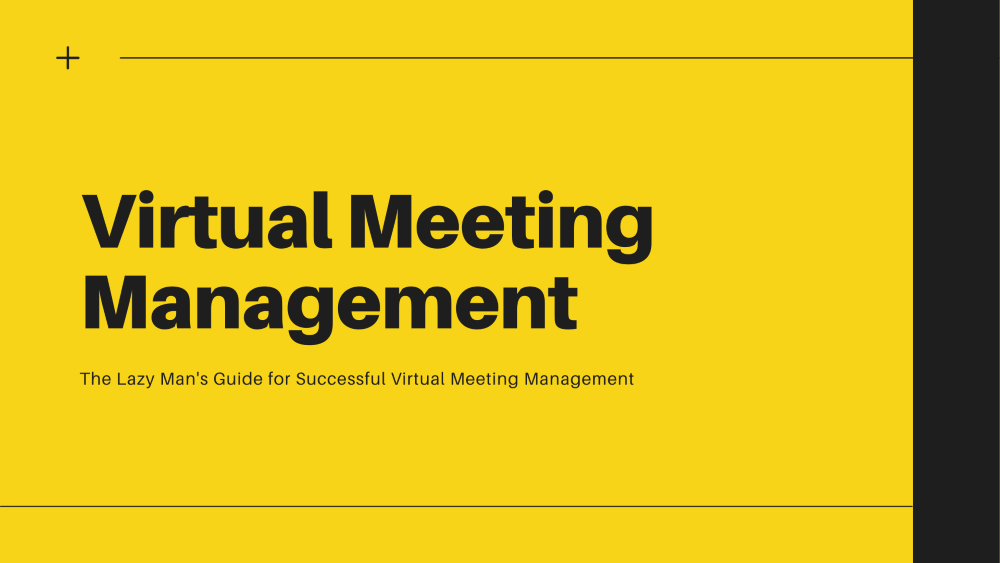
As a result of the pandemic and the imposed lockdowns, businesses and employees worldwide have shifted to a virtual dynamic that helps them deal with everyday issues at an efficient pace. While initially, it was challenging for businesses to adapt to virtual meetings, today, it is a widely used method. According to statistics, businesses using Microsoft Teams went from 50,000 organizations in 2017 to 500,000 in 2020!
So, how do businesses carry out virtual meeting management in the most efficient possible manner? Read on to get a glimpse at the lazy man’s guide for successful virtual meeting management.
1. Plan In Advance
We can’t stress enough the importance of planning your meetings. Often employees have the idea that virtual meetings are easy and laidback, so they don’t put enough effort or attention. Don’t instill any such ideas; instead, plan your virtual meetings to ensure the seriousness of the task on hand; this is also a great way to avoid absenteeism. Inform your employees early and ask them to clear their calendars for the chosen date.
2. Check Tech Beforehand
One of the most common issues faced during virtual meetings is technological breakdowns. While it is impossible to completely avoid these breakdowns, you can always minimize the number of times you get hit with technological uncertainties. Always check all your devices a couple of days before the meeting and a day before. Furthermore, ask all attendees to go through their devices ad test the technology beforehand to avoid any last-minute disruptions.
3. Icebreakers
Lack of engagement and attention is a major reason virtual meetings often don’t work out. Fortunately for organizers, this hurdle can be tackled with ease through the help of icebreakers and virtual team-building activities. Since your team is away from the electricity of the workplace, it is very common for them to feel disconnected and isolated.
To deal with this dilemma, try to incorporate funny videos, jokes, funny quizzes, digital games, or interactive questions to keep them engaged and wake them up. Icebreakers can also recreate interpersonal bonds that were previously broken due to the pandemic.
4. Encourage Video Calls
While it is always easier to opt for your classic dial-in or audio calls, try to gravitate more towards video conferencing. Encourage your team to turn on their videos during the calls to keep themselves actively engaged, similar to how they would kin an in-person meeting. Sometimes people tend to turn in their video, and all the participants can see is a fan or wall. Focus on the faces being visible.
This might take some time for the team to adjust, but it is great to bring back the in-person sensation. The same goes for the host as well. Always look in the camera directly while addressing the team to prove your complete attention.
5. Keep Audio Option
While it is suggested to go for video conferencing on applications such as Microsoft Teams or Zoom, always keep the option for audio calls open. When video conferences can help keep all your participants engaged, it also has the potential to ruin a series of virtual meetings. How so?
For adequate video conferencing, all participants must have a strong internet connection which is not always possible. Save the sanity of your virtual meetings by compromising on the video calls if need be.
6. Make A Plan
A plan is always helpful to ensure that a meeting doesn’t go off course and that everyone understands what’s coming up next. Meetings may quickly go off course and even get chaotic if no plan is in place. Important work may not be done on time because of this.
Planning is needed before determining whom, where, when, and the what’s of each project’s goals and how the goals should be achieved. The more prepared you are, the more likely the meeting will be a hit. A detailed agenda should have the topics for discussion, the purpose of the meetings, the assignment for team members, and the minutes allocated for each topic.
7. Avoid Participation Issues
It is very common for meetings to go on longer than expected. Often, organizers also feel like their attendees are zoning out or just using their cell phones or scrolling during the meetings. If you fear the same might happen to you, jot down a list of questions and ask them during the meeting after regular intervals.
Make sure that the questions don’t put anyone on the spot but keep everyone hooked. Often, participation issues can also arise when people start taking over each other. Encourage your team to use options like “Raise Hand” or wait for you to call on them.
8. Don’t Multitask
In-person meetings used to have different energy since everyone’s attention would be on the table and the topic at hand. However, the same is not the case with virtual meetings. During virtual meetings, it is very common for both the hosts and the attendees to multitask and cater to other issues during the meeting. Please don’t do it and discourage your team from doing it.
9. Use A Facilitator
The last lazy man’s trick to successful virtual meetings is to opt for a responsible facilitator. Leading an in-person meeting is easy, but that’s not the case with virtual meetings since many other complexities are involved. By assigning a facilitator, you will have an individual working on guiding the conversation and the direction of the meeting. Facilitators can also try out polling methods to get everyone’s view on a certain decision. Furthermore, real-time feedback can also be obtained with the help of a facilitator.
Holding successful virtual meetings is not everyone’s cup of tea, as there is a ton to keep into consideration. By following the steps mentioned above, you can make your way towards a successful virtual meeting management journey.
![]()
Advertisements









